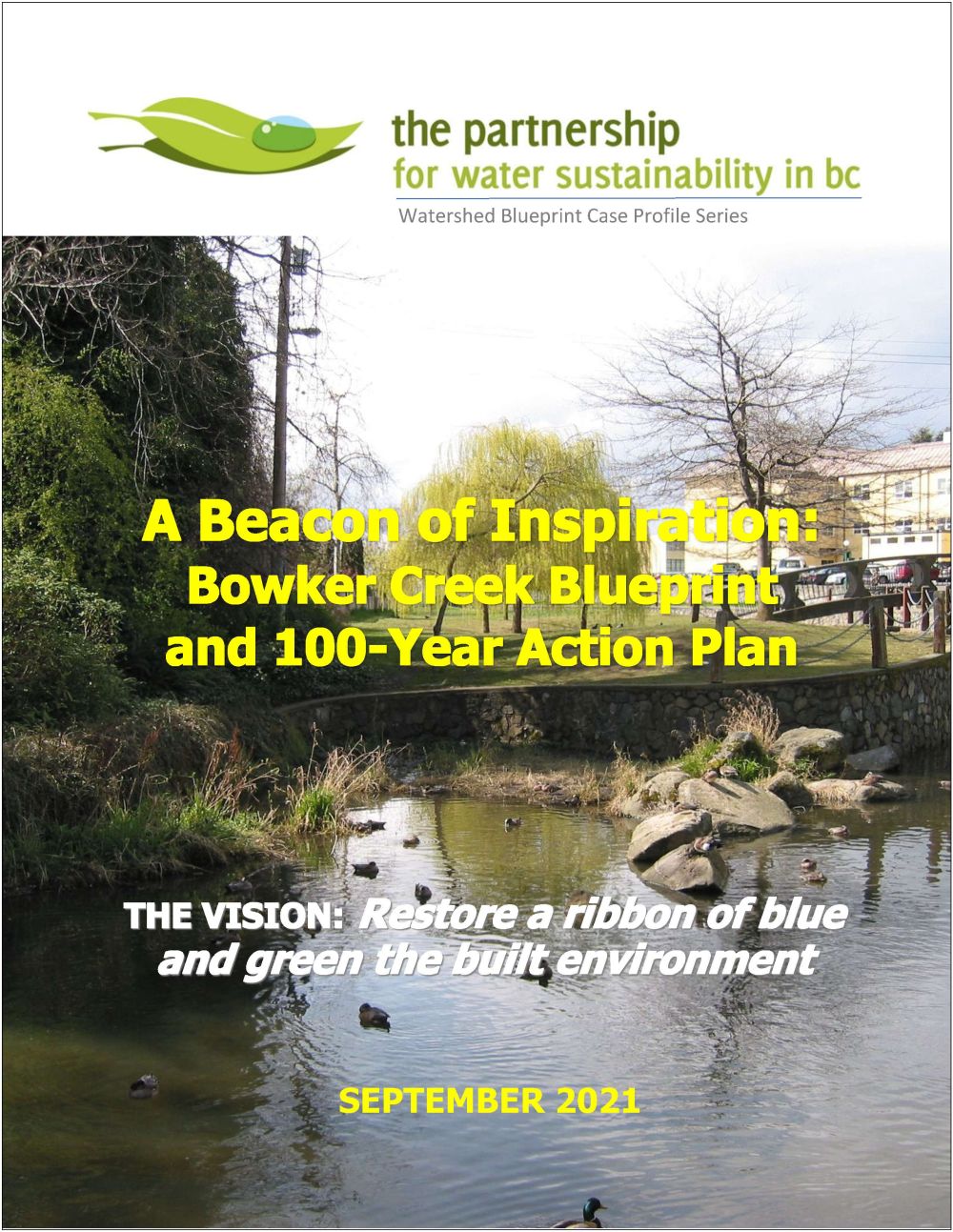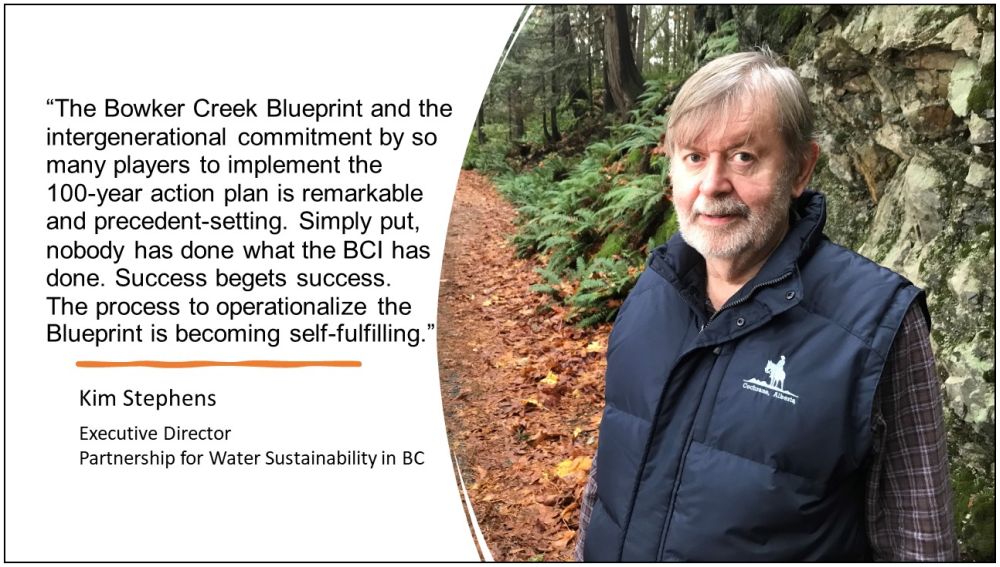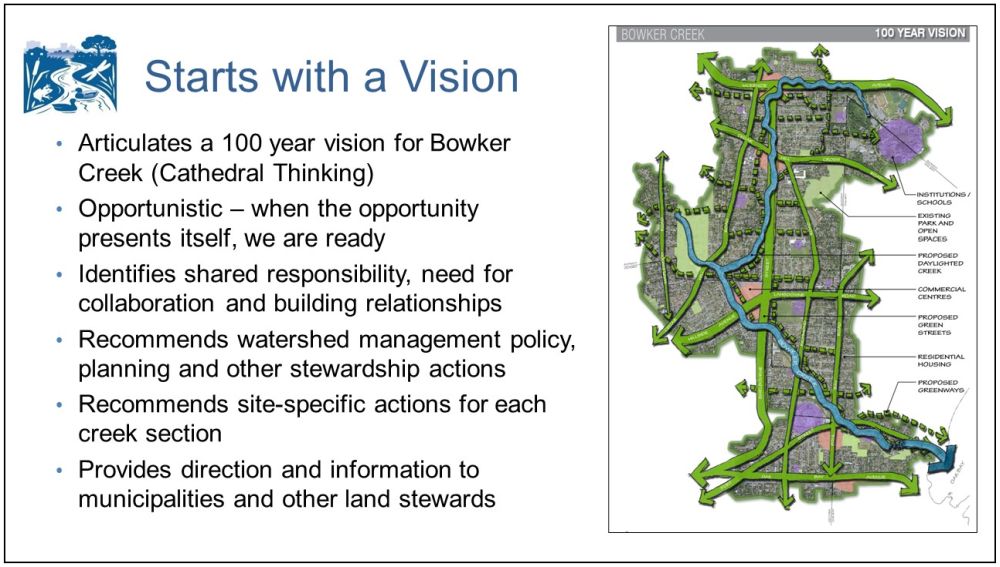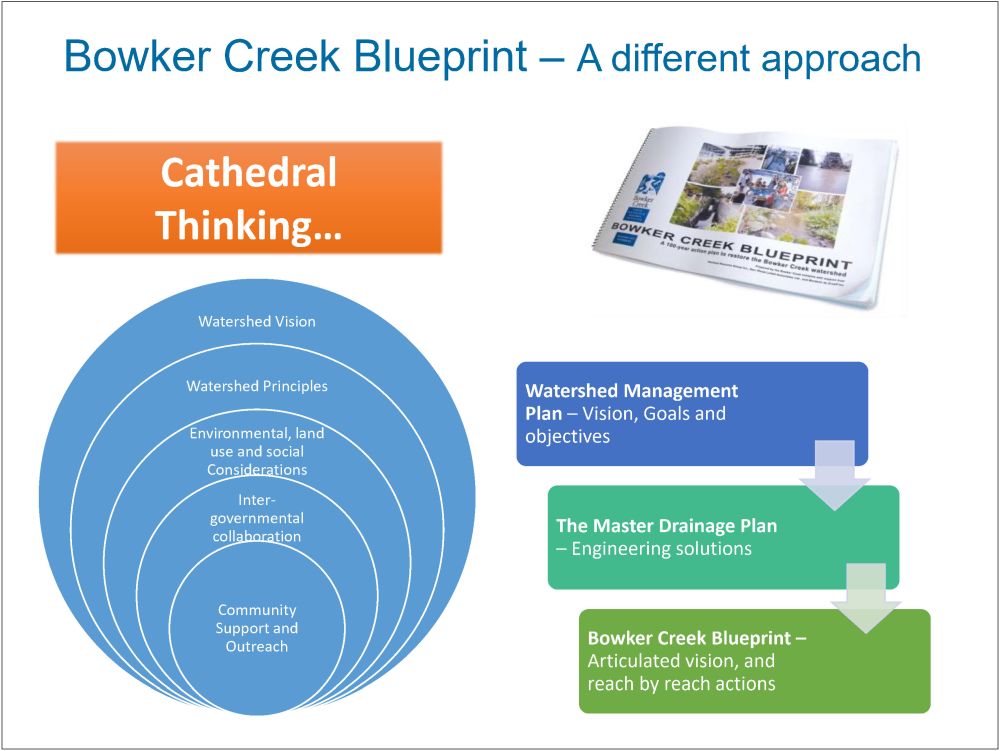FRAMEWORK FOR COLLABORATIVE INTER-MUNICIPAL WATERSHED IMPLEMENTATION IN BRITISH COLUMBIA’S CAPITAL REGION: “We ask property redevelopment proponents how they plan to achieve the goals for the Council-endorsed 100-year action plan for the Bowker Creek Blueprint. They are adjusting their designs, and on a voluntary basis,” stated the City of Victoria’s Brianne Czypyha at an inter-regional seminar titled “A Beacon of Inspiration on Vancouver Island”, and hosted by the City of Vancouver’s Green Infrastructure Implementation team (September 2021)
Note to Reader:
In September 2021, the City of Vancouver’s Green Infrastructure Implementation team invited local government members of the Bowker Creek Urban Watershed Renewal Initiative (BCI) in the Capital Regional District (on Vancouver Island) to share the story of the BCI journey at a “Chat and Chew” lunchtime seminar.
Bowker Creek originates at the University of Victoria and flows for 8 km through three municipalities – Saanich, Victoria and Oak Bay. The creekshed is completely urbanized. The impervious area coverage is 56%. Two-thirds of the creek is buried in pipes.
 The Bowker Creek Blueprint is the outcome of a unique multi-jurisdictional effort. A decade ago, this resulted in the vision to daylight the creek and restore a continuous riparian corridor. The process to operationalize the Blueprint is now self-fulfilling. It is embedded in three Official Community Plans and cascades down to the DNA and departmental work plans within each municipality.
The Bowker Creek Blueprint is the outcome of a unique multi-jurisdictional effort. A decade ago, this resulted in the vision to daylight the creek and restore a continuous riparian corridor. The process to operationalize the Blueprint is now self-fulfilling. It is embedded in three Official Community Plans and cascades down to the DNA and departmental work plans within each municipality.
The Bowker Creek Blueprint is a 100-year action plan to peel back the pavement, daylight an historical creek, and restore nature within the Victoria urban region on Vancouver Island. The intergenerational commitment by so many players is inspirational.
In February 2021, the 12-clause motion passed by Victoria City Council is the game-changer that launched the second decade of the 100-Year Action Plan. In addition to recommitting the City of Victoria to implement the Blueprint, Council directed staff to report back on scope and resources needed to daylight certain reaches of the creek identified in the Daylighting Feasibility Study.
The idea of the intergenerational baton is relevant as a metaphor for the current process for passing on experience, knowledge, and wisdom. The intergenerational commitment by so many players to collaborate and implement the 100-Year Action Plan is remarkable.

Watch the YouTube Video of the tag-team presentation by Kim Stephens, Jody Watson and Brianne Czypyha:
Jody Watson, Capital Regional District, first explained the process that the BCI steering committee went through to get the Bowker Blueprint to where they are at in 2021. Then she handed off to Brianne Czypyha, City of Victoria, to elaborate on how implementation on the ground is happening, including a perspective on opportunities and challenges.
Intergovernmental knowledge-sharing about “A Beacon of Inspiration: Bowker Creek Blueprint and 100-Year Action Plan”
“I have been an observer of the Bowker Blueprint process since 2008. In my professional experience over four decades, nobody anywhere has done what the Bowker Creek Urban Watershed Renewal Initiative (BCI) has done and continues to do,” stated Kim Stephens, Partnership for Water Sustainability Executive Director, when he introduced Jody Watson of the Capital Regional District and Brianne Czypyha of the City of Victoria.
“The Partnership is proud to tell the Bowker story in our Watershed Case Profile titled A Beacon of Inspiration. This is a short history of building bridges of understanding from the past to the present and future. It is a story of local government champions and community leaders who share a vision, embrace shared responsibility, and are bringing Bowker Creek back to life.”
“Why is the Bowker Creek Blueprint and 100-Year Action Plan a ‘beacon of inspiration’? It is the outcome of a unique multi-jurisdictional effort, and this alone is defining. More importantly, it is a story about people who really care and believe in the mission. Their efforts demonstrate why and how it takes hard work to transform the vision for Living Water Smart in British Columbia into actions on the ground.”
“Without determined champions, nothing gets started and nothing happens. Key words that capture the essence of the Bowker story are perseverance, dedication, and TIME in capitals. Most importantly it is about the right people in the right place at the right time, over time.”
“Based on the interviews that are synthesized in A Beacon of Inspiration, the motivation for those involved is clear: It is the Blueprint mission.”
To Learn More:
A Beacon of Inspiration is the 10th in the Partnership’s Watershed Blueprint Case Profile Series. Because there is no equal to the Bowker Creek Blueprint and the intergenerational 100-Year Action Plan, the intent is that this “story behind the story” will have lasting value as a legacy resource for the Bowker Creek Urban Watershed Renewal Initiative. The Partnership’s hope is that others will be inspired by the Bowker experience.
To read the complete story, download a copy of A Beacon of Inspiration: Bowker Creek Blueprint and 100-Year Action Plan.

Bringing Bowker Creek Back to Life in the Capital Region: Community Buy-In is Key
The Capital Regional District (CRD) has the coordinating role and chairs the BCI. After the BCI was created in 2004, Jody Watson was appointed as Chair in 2005 and served in that capacity until 2018. Her tenure was a remarkable period of 13 years of notable accomplishments. In her current role at CRD, Jody Watson continues to provide oversight for the coordinator function.
“The BCI is more than the people sitting around the BCI table. They are representatives of an extensive network that includes three Councils, every department, 11 community associations, and the CRD too. This network is a true community-driven collaboration made up of people with a lot of heart, grit, commitment, and dedication. They are dedicated to achieving the Bowker Blueprint vision. That is what makes it the best. We are watching it implement organically and operationally. We can be proud of our accomplishments,” stated Jody Watson.
To Learn More:
Download a copy of Bringing Bowker Creek Back to Life in the Capital Region: Community Buy-In is Key and follow along while you watch the YouTube video – from about the 4-minute mark through until the 30-minute mark – to learn what Jody Watson had to say when she set the scene for Brianne Czypyha.

The 100-Year Action Plan Starts with a Vision
“Even though we had a watershed plan, things were still not happening on the ground,” continued Jody Watson. “Part of the reason for the lack of action is that development happens on a site-by-site basis. This is illustrated by the action in the watershed vision to create a greenway. The disconnect is that municipal staff reviewing a development application had no guidance as to how an individual site might fit within an overall greenway through the entire watershed. To address this need, we brought together staff from all three municipalities to figure out what the route would be so that it gave the individual planners and engineers that context.”
“We kept bringing together multi-municipal and multi-departmental working sessions to figure out individual pieces of what became the Blueprint. We had disparate studies all over the place. And that became a challenge for the municipalities. Which study do I look at, they would ask? I just need one document, they would add, that says here is what I need to do for the creek.”
“We kept going back to the vision. And so, we arrived at the Blueprint which pulled everything together into a single document. But there were a lot of challenges in how to take it forward to the three Councils. That is when the idea of a 100-year action plan emerged. That was the game-changer. We decided not to put dollar amounts in the Blueprint document. We changed the focus to how we will be ready when the opportunities present themselves?”
“The Blueprint identifies shared responsibility. We have to be collaborative to fix this watershed. And that relies on building relationships.”
To Learn More, Watch the YouTube Video!


Re-development Creates the Opportunity for Creek Daylighting
“We were still challenged in figuring out how do we get the creek out of the pipe,” emphasized Jody Watson. “It was the same thing as happened with the greenway. Development is happening but what we don’t know is the route of a daylighted creek. So, how do we figure out how individual properties fit into that overall vision?”
“We finally got to the point of proceeding with the daylighting feasibility study which we have now completed. It defines a route for daylighting all the enclosed sections of the creek. We again brought together multiple departments from all three municipalities. We defined where could it go? Where can’t it go? As an outcome, we believe that over 95% of the creek can be daylighted over time.”
“We also incorporated the greenway so that that is re-envisioned as linked to potentially daylighted areas. The entire watershed is in a phase of redevelopment and infrastructure renewal. So, the daylighting study was a key piece that we needed to get done to be ready for that redevelopment.”
To Learn More, Watch the YouTube Video!

Framework for Collaborative Inter-Municipal Implementation
“Where we are at now is that we have all this new information, including conceptual designs for daylighting in certain areas. Another thing that we worked on is a Framework for Collaborative Inter-Municipal Implementation. Basically, we did a gap analysis of everyone’s bylaws and mechanisms that they can use to implement various aspects of the Blueprint. We then suggested how we can work together to get consistency in an array of areas.”
“We are bringing together the municipalities over the next year or two, and we are incorporating new information. Our intent is to come out of this process with an updated Bowker Blueprint 2.0 (which is now the 90-year action plan),” summarized Jody Watson.
To Learn More, Watch the YouTube Video!



To Learn More, Watch the YouTube Video!
Bowker Creek Urban Watershed Renewal – City of Victoria Perspective
Brianne Czypyha, Stormwater Management Specialist with the City of Victoria, offers unique insights because of her sense of history combined with the significant role that she plays as both a champion and interpreter for the Bowker Creek Blueprint. She began her career in local government with the CRD and then joined the City of Victoria in 2013.
“At CRD, I was an observer of the process of putting the Blueprint together. I remember the blood, sweat and tears that went into the Blueprint. It was so inspiring to see it happen. For me, it was interesting being a party to the conversation because I was a member of the CRD watershed team. Now I am taking the next step at the City of Victoria where I am on the implementation side of the Blueprint. This is what really pulls it all together for me,” stated Brianne Czypyha.
To Learn More:
Download a copy of Bowker Creek Urban Watershed Renewal – City of Victoria Perspective and follow along while you watch the YouTube video – from about the 30-minute mark through until the 50-minute mark – to learn what Brianne Czypyha had to say.

Watershed Challenges
“Jody Watson explained the process to get where we are now. My focus is on the City of Victoria perspective and how urban watershed renewal fits into our setting, our approach to stormwater (rainwater) management, and how we can continue to move this forward from where we are at this moment,” continued Brianne Czypyha.
“Most of Victoria’s drainage system was constructed over 100 years ago. We are continually dealing with the need for renewal. As well, we are seeing a decrease in the urban forest canopy and an increase in impervious area. We have frequent water quality issues. We also have a long history of burying our creeks. As a result, the City of Victoria has one 400m long section of restored creek. That’s it! The rest of our historic creeks are buried underground.”
“Over the past 20 years of so, the City of Victoria has realized that we really need to make changes. We are implementing green stormwater infrastructure. And we have implemented a stormwater utility for funding of infrastructure improvements.”
To Learn More, Watch the YouTube Video!
Cathedral Thinking
“We had this idea of cathedral thinking (as a way to explain the 100-year approach),” stated Brianne Czypyha. “The Blueprint articulates the necessary actions, reach-by-reach, that need to be taken to help us achieve the Bowker vision. We are at the point where we have this great cathedral thinking and a blue-sky vision for a functioning creek that has ecological value, and we can apply it on the ground.”
“By having a long-term vision, and breaking it into smaller chunks that are achievable, it was so much easier to get Council support and endorsement. The 100-year timeline makes the plan less scary and therefore more achievable.”
To Learn More, Watch the YouTube Video!

Bowker Creek Blueprint: Framework for Collaborative Inter-Municipal Watershed Implementation
“We have had some great successes over the past 10 years through a focus on short-term actions. One of our successes is the Rainwater Rewards incentive program. We have a combination of rebates and credits that encourage people, during the property redevelopment stage, to look at how they can incorporate green infrastructure into their properties. This was a huge change for the City of Victoria. We are now in Year Six,” explained Brianne Czypyha.
“The big takeaway is that we now have those conversations with developers at the redevelopment stage about what they will do on their properties. In the case of Bowker Creek, we point out that properties are in the watershed. We ask them how they plan to achieve the goals for the Council-endorsed 100-year plan. They are adjusting their designs, and on a voluntary basis.”
“While we have had early successes, we must recognize that a 100-year plan will have a lot of challenges. And so, we are thinking about how we will achieve intergenerational implementation. This is an important consideration as people retire or leave.”
To Learn More, Watch the YouTube Video!

“How do we ensure, for example, that we don’t miss those opportunities when properties are coming up for redevelopment. How do we ensure that we are asking for the right things?”
“The Framework for Collaborative Inter-Municipal Watershed Implementation is a fantastic document. It identifies what planning tools we can use for implementation of the Bowker Creek Blueprint. The three municipalities have taken different approaches to how we are implementing the Blueprint. At the end of the day, the shared goal is to achieve the vision for a fully restored creek.”
“The Framework has a private land focus. We want to manage rainwater where it falls. The Framework reflects the different conditions in the three municipalities.”
“In February 2021, Council recommitted to implementing the Blueprint and gave staff direction to develop cost estimates, for inclusion in the City of Victoria’s 2022 Financial Plan, to daylight specific sections. An exciting outcome is that we are looking at applying the Blueprint approach to other urban waterways. We are looking at the question of how to scale this up and apply it in other areas of the City of Victoria where historic waterways have been piped and the creeks eliminated from the urban fabric.”
“There are challenges, especially ensuring continuity and bringing everyone along. The key is the coordinator role. Having that one person whose job it is to move the Blueprint forward and ensure that we are all communicating is how we maintain momentum,” concluded Brianne Cyzpyha.
To Learn More, Watch the YouTube Video!








